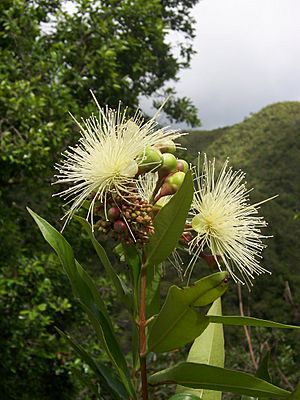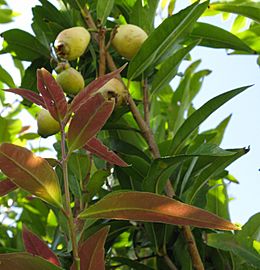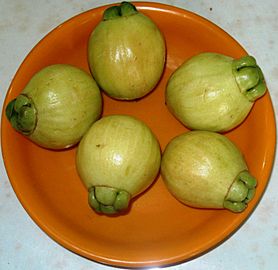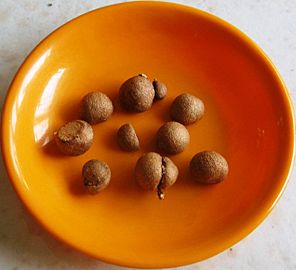Rose apples facts for kids
Quick facts for kids Rose apples |
|
|---|---|
 |
|
| Conservation status | |
| Scientific classification | |
| Genus: |
Syzygium
|
| Species: |
jambos
|
| Synonyms | |
|
Eugenia jambos |
|

Fruit and seeds. One fruit is split to show seeds.
|
|
| Nutritional value per 100 g (3.5 oz) | |
|---|---|
| Energy | 105 kJ (25 kcal) |
|
5.7 g
|
|
|
0.3 g
|
|
|
Protein
|
0.6 g
|
| Vitamins | Quantity
%DV†
|
| Vitamin A equiv. |
2%
17 μg |
| Thiamine (B1) |
2%
0.02 mg |
| Riboflavin (B2) |
3%
0.03 mg |
| Niacin (B3) |
5%
0.8 mg |
| Vitamin C |
27%
22.3 mg |
| Minerals | Quantity
%DV†
|
| Calcium |
3%
29 mg |
| Iron |
1%
0.07 mg |
| Magnesium |
1%
5 mg |
| Manganese |
1%
0.029 mg |
| Phosphorus |
1%
8 mg |
| Potassium |
4%
123 mg |
| Sodium |
0%
0 mg |
| Zinc |
1%
0.06 mg |
|
Link to USDA Database entry
|
|
| †Percentages estimated using US recommendations for adults. | |
The Syzygium jambos is a type of rose apple tree. It first grew in Southeast Asia. People have planted it in many other places around the world. They grow it because it is a beautiful ornamental tree and it produces tasty fruit.
Contents
What is a Rose Apple Tree?
The Syzygium jambos can be a large shrub or a small to medium-sized tree. It usually grows about 3 to 15 meters (10 to 50 feet) tall. It often has branches that grow low to the ground.
Its leaves and small branches are very smooth. The bark is dark brown but also quite smooth. The leaves are shaped like a spear (called lanceolate). They are about 2 to 4 cm (0.8 to 1.6 inches) wide and 10 to 20 cm (4 to 8 inches) long. They have a pointed tip and a wedge-shaped base. When they are new, they are bright red. As they grow, they turn a dark, shiny green.
The flowers grow in small groups at the ends of the branches. They are white or greenish-white. They have many long stamens (the parts that hold pollen), which makes them look big, about 5 to 8 cm (2 to 3 inches) wide. In places with different seasons, the tree flowers in the summer.
The Fruit
The fruit of the Syzygium jambos looks a lot like some types of guava. If you don't know the fruit, you might think it's a guava. However, the smell, taste, and texture are different.
A guava has many small, hard seeds inside a jelly-like center. But the Syzygium jambos fruit usually has only one or two large seeds. These seeds are about 1 cm (0.4 inches) wide and sit loosely inside a slightly fluffy space when the fruit is ripe. If you shake a ripe fruit, you might hear the seeds rattle! The skin of the fruit is thin and feels waxy.
Some people say the flowers smell nice. The ripe fruit has a strong, sweet, flowery smell. This is why it's often called "Rose apple" or "pomarrosa."
Names for the Rose Apple
Scientific Names
The scientific name for this plant is Syzygium jambos.
- Family: Myrtaceae
- Genus: Syzygium
- Species: jambos
This tree has been called by different scientific names in the past, like Jambosa or Eugenia. But now, scientists agree that its correct name is Syzygium jambos. There are also different kinds of Syzygium jambos with various fruit colors, but they are all the same species.
Common Names
The Syzygium jambos has many common names. This is because it grows in many different places as a garden tree or fruit tree. Some of its names include:
- Malabar Plum
- Mountain Apple
- Water Apple
- Cloud Apple
- Wax Apple
- Rose Apple (a very common name)
- Pomarrosa
Many of these names are also used for other similar fruits. For example, the word "jambu" can sometimes mean a guava. In India, many languages use similar words for a different, smaller, dark purple fruit. In some places like Bangladesh, it's called "golap-jaam," which means "rose jaamun," because of its special smell.
In the Philippines, it's called yambo, dambo, or tampoy. It's often confused with a similar fruit called macopa. The Syzygium jambos is not grown as much there and is mostly found in country areas. Lake Yambo in the Philippines is named after this fruit.
In Maldives, it's called Jambu.
In Brazil, the fruit is simply called jambo.
Different Kinds of Fruit
There are many types of S. jambos trees around the world. In Thailand, the most common type has pale green fruit. In Malaysia, the fruits usually have red skins. In many other places, the fruit is a light yellow color, sometimes with a little pink blush.
The fruit's skin is thin and waxy. Inside, the hollow center has a small amount of soft fluff. The fruit's flesh is crunchy and watery. It has a special taste that some people describe as a mix between a nashi pear and a bell pepper, with a light rose smell and a slightly bitter taste.
Where Rose Apples Grow
The rose apple tree has been planted in many parts of the world, except Antarctica. It has even started to grow wild and spread in some areas. People are worried that it might harm some natural places, like islands in Hawaii, Réunion, and the Galápagos Islands. It also grows in parts of Australia and warmer areas of the Americas. However, in Hawaii, a type of fungus called Puccinia psidii has almost wiped out the rose apple trees there.
How People Use Rose Apples
The fruit is full of vitamin C. You can eat it fresh, or people use it in different recipes in various countries. In Southeast Asia, rose apple fruit is often served with spiced sugar.
The wood of the tree is very strong and is used to make charcoal.
Different parts of the tree have special substances called tannins. These tannins can help fight germs. Some parts of the tree are also used in traditional medicine in certain regions.
See also
 In Spanish: Syzygium jambos para niños
In Spanish: Syzygium jambos para niños






